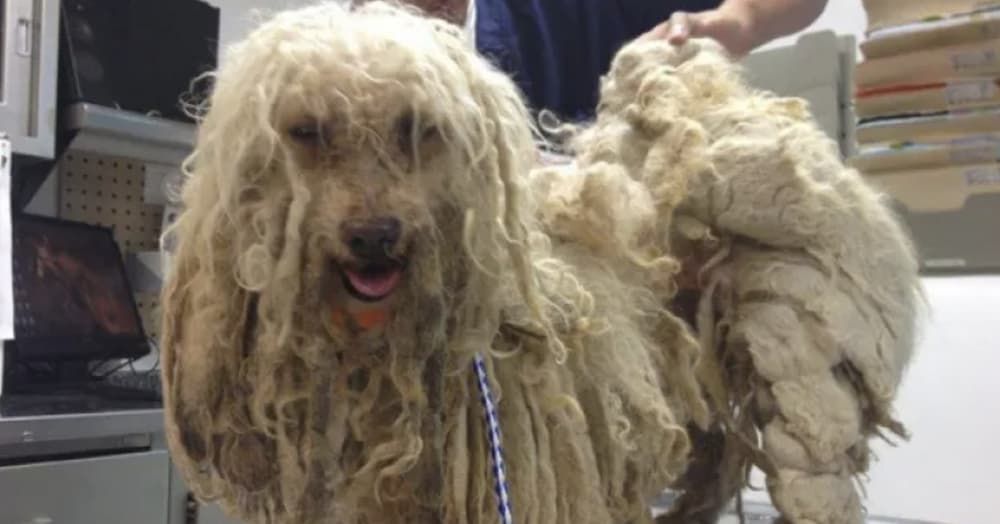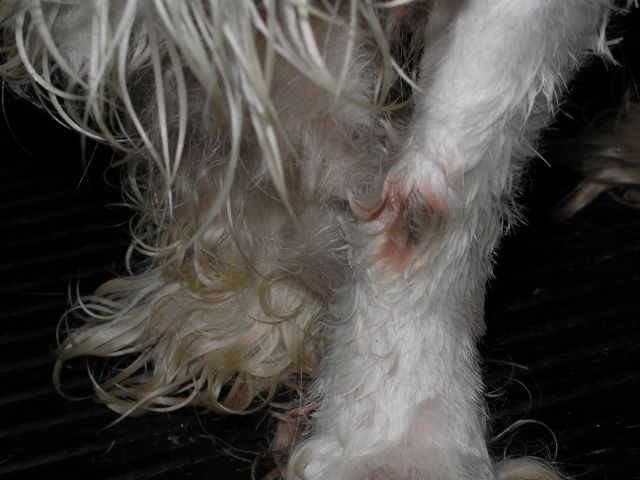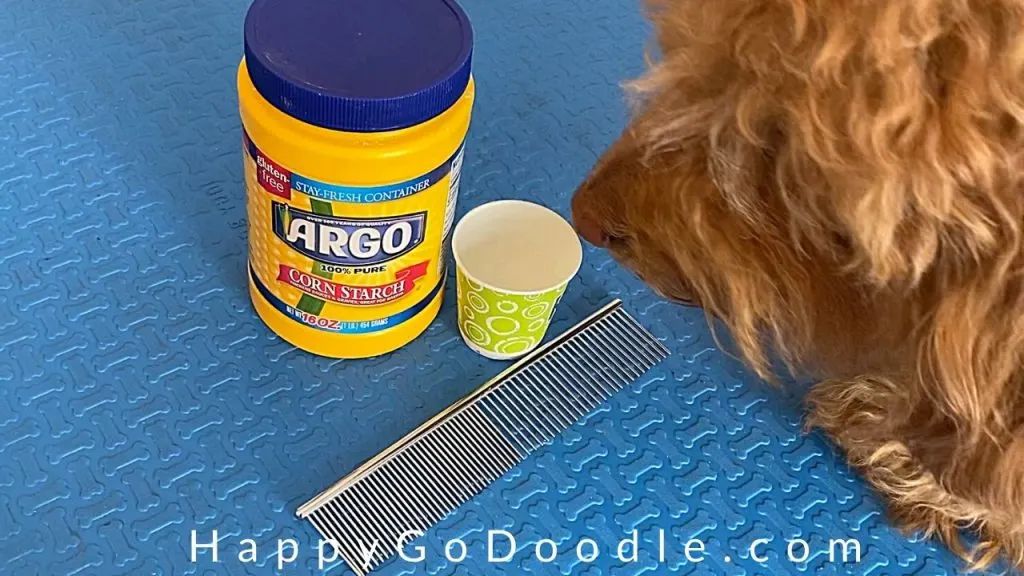Introduction
Matted hair is a common issue for dogs, especially those with long or thick coats. As fur becomes tangled and forms dense mats close to the skin, it can cause discomfort, skin irritation, and even sores on dogs. Sores from matted fur occur when the mats pull on the skin, restricting blood flow and causing wounds. Severely matted coats also trap moisture, dirt, and debris against the skin, leading to infection. While grooming can prevent mats from forming, dogs with matted coats require gentle treatment to avoid further pain and injury. This guide covers the causes, risks, and treatments for matted hair and resulting sores in dogs.
Causes of Matted Hair

There are several common causes that can lead to matted fur in dogs:
Lack of regular grooming is a major cause of matted fur. When dogs are not brushed thoroughly and regularly, loose hair can get tangled and form mats, especially in breeds with long fur coats like Shih Tzus, Lhasa Apsos, and Poodles. Frequent brushing helps remove shedded hair and prevent tangles from forming.
Certain skin conditions like allergies or infections can cause excessive shedding, itching, and discomfort. This disruption in the coat leads to tangling and matted fur. Treating the underlying condition is key to preventing recurring mats.
Long hair coats are prone to matting if not properly maintained, as the long hair wraps around itself. Regular brushing and grooming is essential for long haired breeds like Maltese, Yorkshire Terriers, and Chow Chows [1].
Elderly dogs or dogs with limited mobility can have difficulty grooming themselves thoroughly. This allows dead hair and debris to accumulate and tangle in the coat. Providing assistance with grooming helps prevent mats in senior or disabled dogs.
Identifying Matted Hair
Matted dog hair can often be difficult to spot, especially in long-haired breeds. Here are some tips for identifying matted fur on your dog:
Feel along your dog’s coat with your fingers to find any clumps or tangles in the fur. Matted hair will feel like dense wads of fur rather than separate smooth strands.[1] Pay close attention to areas where mats commonly form, like the armpits, behind the ears, and on the belly and legs.
Visually inspect your dog’s coat for any flattened, rope-like sections of fur. Healthy fur should have volume and sheen, while matted fur will appear dull, twisted, and stuck together in clumps.
Be sure to thoroughly check locations prone to matting, like the ears, armpits, sanitary area, legs, and paws. Gently spread the fur in these areas to better see the skin underneath.[2]
Regularly brushing and combing your dog’s coat will help you identify any tangles and mats early on, when they are easiest to treat.
Risks of Matted Hair
Matted hair can pose several health risks for dogs. The primary concerns include:
Skin Irritation and Sores
When hair becomes severely matted, it can pull and tug on the skin, leading to irritation, inflammation and even open sores. The constant friction against the skin causes discomfort. Sores that form under matted clumps are also at risk for infection since they are covered and do not get any air (Understanding the risks of letting your pet become matted).

Infections
Matted clumps create a moist environment against the skin where bacteria and fungus can thrive. This increases the risk of bacterial or fungal skin infections developing under the matted hair (4 Dangers Of Matted Pet Hair). Matted hair also provides a place for parasites like fleas and ticks to hide and multiply.
Mobility Issues
When mats become extensive, they can restrict a dog’s movement. Matted clumps around joints put stress on the area and make it difficult for the dog to move freely. Senior dogs or those with arthritis may have increased soreness and stiffness from matted fur (What Your Groomer Wants You To Know About Matting).
Treating Sores from Matted Hair
When matted hair pulls and tugs at the skin, it can lead to painful sores and skin irritation. These open wounds are vulnerable to infection, so it’s important to properly treat any sores that develop under matted fur.
The first step is to carefully clip the matted sections of hair around the sore using scissors or clippers, taking care not to cut the skin (1). Removing the mats will relieve the tension on the wound and allow air to reach it. Once the hair is trimmed, clean the sore by gently wiping with a warm, wet cloth and a mild soap or betadine solution (2). Be sure to rinse and pat dry. Apply an antibiotic ointment, taking care not to rub too hard.
Check on the sore at least twice a day, cleaning and reapplying ointment as needed. Keep the area shaved as the hair starts to grow back to prevent matting. If the sore doesn’t start to improve within a couple days or shows signs of worsening infection, contact your veterinarian.
Preventing Matted Hair
There are several steps pet owners can take to prevent matted hair in dogs:

Regular brushing is crucial for preventing mats from forming in the first place. Using a slicker brush or dematting comb, owners should brush all parts of their dog’s coat thoroughly at least once per week. Pay extra attention to areas that are prone to matting like the ears, armpits and hind legs.[1]
Keeping your dog’s fur trimmed relatively short makes it easier to brush and maintain. Longhaired dogs are more prone to matting, so asking your groomer to trim the hair to 2-3 inches can help prevent mats from forming as quickly.[1]
Frequent bathing every 2-4 weeks can help loosen dirt and debris that gets tangled in the coat. Be sure to thoroughly brush and completely dry your dog’s coat after bathing. Using a moisturizing shampoo and conditioner formulated for dogs can help keep their skin and coat hydrated.
Feeding your dog a nutritious diet with omega fatty acids can promote skin and coat health. Fish oils, vegetable oils and other supplements can provide oils that keep their fur strong, soft and tangle-free.
When to See a Vet
If your dog has developed sores from matted fur, it’s important to get them checked out by a vet. Here are some signs it’s time for a vet visit:
- Sores oozing pus – This indicates infection that requires medication.
- Increased pain or swelling – The skin damage is worsening and needs treatment.
- Loss of appetite – Pain from sores can cause loss of appetite.
- Lethargy – Matted fur pulling on skin causes fatigue and discomfort.
As mentioned on InsideOutDogTraining, sores that worsen need quick vet attention to avoid escalation. Telltale signs like oozing and swelling mean it’s time for the vet. They can provide medication, drain fluids, and care for open wounds.
Don’t wait if the sores seem infected, according to HoundTherapy. In addition to medication, the vet may recommend shaving the matted fur to allow the skin to heal and prevent further damage.
Getting prompt treatment will relieve your dog’s discomfort. It also prevents the sores from worsening into larger wounds. Don’t hesitate to call the vet if your dog’s sore spots seem to be getting worse.
At-Home Matted Hair Removal

Removing matted hair at home takes patience and care. Have these supplies on hand before getting started:
- Detangling spray – Helps lubricate and loosen mats
- Wide-tooth comb – Gently works through tangles
- Slicker brush – Smooths hair after detangling
- Scissors – Only for cutting out severely tangled clumps
- Treats – Reward your dog for cooperating
Follow these steps to gently remove mats at home:
- Spray detangler liberally over the matted area and let it soak in for 5-10 minutes.
- Gently brush around the edges of the mat with a wide-tooth comb to loosen it.
- Slowly pick apart the mat, starting from the ends and working up towards the skin.
- If needed, use scissors to carefully cut out severely tangled clumps.
- Reward your dog with treats for sitting calmly.
- Once detangled, brush the area with a slicker brush to smooth the coat.
- Avoid pulling or ripping out clumps, as this can be painful and damage the skin.
Remain patient, work in short sessions, and give your dog breaks. Removing mats can be uncomfortable, so staying calm and positive will help the process go smoothly.
Professional Grooming
Taking your dog to a professional groomer is the best option for dealing with severe matting. Groomers have the proper tools, training, and experience to safely detangle and remove matted fur without injuring your dog’s skin.
The benefits of visiting a professional groomer include:
- They can humanely remove matted fur using specialized tools like clippers, scissors, detangling sprays, and dematting rakes. This is less stressful and painful for the dog compared to an owner trying to cut out mats at home (Source).
- Groomers are trained to identify and avoid cutting irritated or damaged skin hidden beneath mats.
- They can advise on the best grooming schedule and techniques to prevent future matting.
When visiting a groomer, expect them to evaluate your dog’s coat and determine the safest method for removing mats. This may involve shaving your dog’s fur quite short. Don’t be alarmed – this allows the skin to heal and fur to regrow healthy. Discuss options with your groomer. Costs vary depending on the severity of matting and time required, but expect to pay $60-100 or more for dematting (Source).
Providing Comfort
When dogs have sores from matted hair, it’s important to help provide them comfort while their skin heals. Here are some tips:
Gently massage any sore areas to increase blood flow and help reduce pain and inflammation. Use a soothing natural oil like coconut oil. Be very gentle and stop if the dog shows any sign of discomfort.
Provide soft bedding and blankets for the dog to lay on. This will cushion any tender areas and let the dog rest comfortably. Use beds and blankets that can be washed frequently.
Consider giving dietary supplements that support skin health and reduce inflammation. Fish oil, vitamin E, zinc, and probiotics may help speed healing. Consult your veterinarian for dosage recommendations.
Let the dog rest and recover in a quiet, calm environment. Limit activities that might irritate sore skin areas. Provide engaging toys and chews to help prevent boredom.
Be patient and compassionate as the dog recovers. Give them plenty of affection to help them feel secure. With some time and care, most dogs bounce back quickly after getting matted fur shaved.
